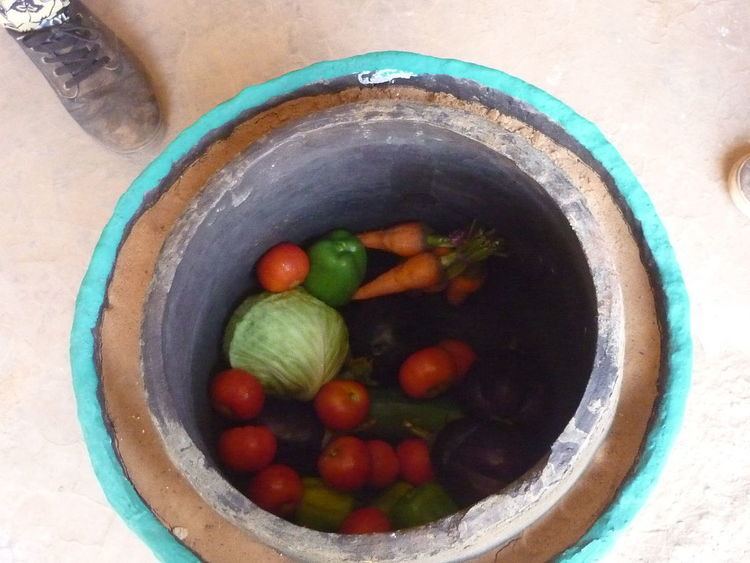 | ||
A pot-in-pot refrigerator, clay pot cooler or zeer (Arabic: زير) is an evaporative cooling refrigeration device which does not use electricity. It uses a porous outer earthenware pot, lined with wet sand, contains an inner pot (which can be glazed to prevent penetration by the liquid) within which the food is placed - the evaporation of the outer liquid draws heat from the inner pot. The device can be used to cool any substance. This simple technology requires only a flow of relatively dry air and a source of water.
Contents
History
There is some evidence that evaporative cooling was used as early as the Old Kingdom of Egypt, around 2500 B.C. Frescos show slaves fanning water jars, which would increase air flow around the porous jars and aid evaporation, cooling the contents. These jars exist even today and are called "zeer", hence the name of the pot cooler.
Many earthenware pots were discovered in Indus Valley Civilization around 3000 BC which were probably used for storing as well as cooling water similar to present-day ghara or matki used in India and Pakistan.
Despite being developed in Northern Africa, the technology appears to have been forgotten with the advent of modern electrical refrigerators. However, in the Indian Subcontinent, ghara, matka and surahi, which are different types of earthenware water pots are used to cool water. In Spain, botijos are popular. A botijo is a porous clay container used to keep and to cool water; they have been in use for centuries, and are still relatively widespread. Botijos are favored most by the low Mediterranean climate; locally, the cooling effect is known as "botijo effect".
In the 1890s gold miners in Australia developed the Coolgardie safe, based on the same principles.
In rural northern Nigeria in the 1990s Mohamed Bah Abba developed the Pot-in-Pot Preservation Cooling System, consisting of a small earthenware pot placed inside a larger one, and the space between the two filled with moist sand. The inner pot is filled with fruit, vegetables or soft drinks and covered with a wet cloth.
Abba, who hails from a family of potmakers, tapped into the large unemployed local workforce and hired skilled pot makers to mass-produce the first batch of 5,000 Pot-in-Pots. He received the Rolex Award for Enterprise in 2001 and used his $75,000 award to make the invention available throughout Nigeria. Abba devised an educational campaign tailored to village life and the illiterate population featuring a video-recorded play by local actors to dramatise the benefits of the desert refrigerator. The pots sell at 40 US cents a pair.
After the millennium several international NGOs started to work on the dissemination of this technology in various African countries: Practical Action in Sudan and Humanity first in Gambia and Movement e.V. in Burkina Faso.
Construction
A zeer is constructed by placing a clay pot within a larger clay pot with wet sand in between the pots and a wet cloth on top.
The device cools as the water evaporates, allowing refrigeration in hot, dry climate. It must be placed in a dry, ventilated space for the water to evaporate effectively towards the outside. Evaporative coolers tend to perform poorly or not at all in climates with high ambient humidity, since the water is not able to evaporate well under these conditions.
If there is an impermeable separation layer between the food and the porous pots, undrinkable water such as seawater can be used to drive the cooling process, without contaminating the food. This is useful in arid locations near the ocean where drinkable water is a limited commodity, and can be accomplished by using a pot that has waterproof glaze or cement applied to the inner wall where the food is stored.
Extended operation is possible if the pots are able to draw water from a storage container, such as an inverted airtight jar, or if the pots are placed in a shallow pool of water. A strap can be used to tie the inner pot down instead of using sand to prevent it from floating.
Effectiveness
The effectiveness of evaporative cooling varies with the temperature, humidity and airflow. Given a constant flow of cool dry air the inner pot can achieve temperatures as low as 40 °F (4.4 °C), which is the temperature below which mesophilic ("middle temperature") bacteria such as food spoilage bacteria have significantly slowed growth.
Impact
Pot-in-pot refrigeration has had multiple positive impacts on the population that uses them beyond the simple ability to keep food fresh for longer periods of time and decreasing instances of food-related disease.
A zeer costs about 150 naira (approximately US$1.00 in 2011) to make in Nigeria, and they sell for 180-200 naira (US$1.20 to US$1.30 in 2011).
